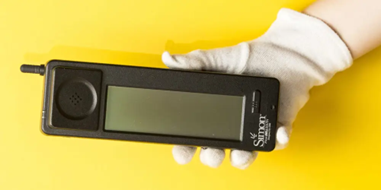
Vision is how we interpret the world. It’s our most dominant sense, and the evolution of technology has further elevated our need for compelling visuals.
But how did this preference for visual consumption of information begin? Over the last century, since the invention of television and the silicon age, people have become biased towards visual storytelling. Smartphones, streaming services, and social platforms have become the dominant ways in which people consume content every day of their lives. In this digital age, people demand visual mediums over print and audible methods to be entertained and enthralled.
If the average person expects it in their everyday life, that means the average juror will expect it in court.
That’s why civil attorneys who use visual litigation strategies during trial have a better chance of connecting with the jury (or judge) and keeping their attention. This deeper empathy and comprehension could increase the chances that your case ends with a favorable verdict.
In this blog post, we’ll explore the history and reasons why people, i.e., your potential jurors, not only prefer but demand visuals. To start, we need to explore the history of how visuals became the favorite medium of consuming information.
How Visuals Have Triumphed Over Audio
In 1895, the way people consumed information and entertainment was revolutionized. The invention of the radio was, at the time, considered the height of entertainment. It became the dominant form of communication, and by 1922 there were 576 licensed radio broadcasters.
But that precedent changed as television became mainstream during the 1950s, after World War II. Soon, half of the American population owned a TV set. This technological milestone forever changed how information and media was delivered and consumed.
Radio tried to adapt by bringing in guest speakers, but it quickly became a form of entertainment-focused on individuals who were not at home. Television brought families together, as a screen captivated viewers of all ages more than listening to a voice.
And then computers arrived.
The takeover of computers wasn’t instantaneous — in fact, there were several decades of building, testing, and adapting technology to get to a computer that resembles what we have today. It took years of research and development for IBM to release their own personal computer (PC) in 1981.

As years passed and prices lowered, computers became more accessible and powerful with every new model. In 1998, Google’s search engine was born. Users could type whatever they wanted into the search engine, and get immediate data. Google Images was then launched in 2001, which provided another method to absorb visual information.
“Getting [visual] information off the Internet is like taking a drink from a fire hydrant.”
Mitchell Kapor, Entrepreneur
People began to see more and more visuals everywhere they went. Then the cellular revolution of the 1990s hit.
Phones needed a large suitcase to function, but over time their designs became sleek and advanced. In 1992, the first mobile phone was released by IBM: the Simon Personal Communicator.

It functioned almost like an iPhone, and thus yet another screen was introduced in people’s lives. Of course, smartphones didn’t take off until 2007, when Apple released the original iPhone. Now, there are billions of smartphone users, and by 2027 it’s estimated that there will be almost 8 billion total users.
This rapid communication change happened over only a few decades! Why? Because our brains are programmed to digest visuals more efficiently than text, which makes computers, television, and screens more appealing. Phones became so popular because they are basically portable screens that house unending visual information.
Most people don’t even think about the amount of screens they see in their day-to-day lives. One study found that every American household has an average of seven screens. A hundred years ago, as families sat around their radios at night, it’s unlikely they could have foreseen a future like this.
This evolution of visual communication is why everyone expects such engaging visuals wherever they go today — including those on the jury.
The data behind memory and visuals
How has the rising use of smartphones and other screen’s through history affected how regular people (and thus, jurors) interpret and remember visuals?
It only takes your brain one-fourth of a second to process an image. Humans are biologically built to process the world in a visual way, and studies have shown that memory is overwhelmingly influenced by imagery.

Half of our brains are directly involved with processing visual information. Both history and data agree that jurors are more likely to favor the use of visuals over purely oral trial presentations.
In one study, people remembered more than two thousand pictures with 90% accuracy over several days, even with short presentation times. Thus, if you present visual court exhibits that highlight your key facts and amplify your argument, the jury will remember it more clearly — and even thank you for it!
“The jury was rapt every time we played [the trial animation] in court and they asked to show it again while deliberating. After the verdict came down, many of the jurors told us that they really liked the video. It brought our case home!”
Jesse Cox, Partner at Lynberg Watkins
The Data Doesn’t Lie: Visual Litigation Tactics are More Compelling
Pictures are remembered better than words, and in trial, this can make the difference to your case receiving a favorable verdict. Images are the visual manifestation of what you are explaining to the jury, and provides another way for them to absorb the facts.
Interested in how your presentation can leverage visuals, but unsure how much they cost? Check out our free pricing guide for legal graphics and animation!
For example, imagine you were on the jury and had no medical knowledge or background. Then, an attorney in their opening statement said, “My client needed two consecutive spinal fusion surgeries to remove osteophytes, which were causing a herniated disk.”
Would the average juror be familiar with this technical lingo? They would most likely not be. Instead, an attorney could say, “This medical animation shows why the patient had to undergo extensive spine surgeries, and explains the procedure.” If you are curious about the actual case that needed this type of visual litigation strategy, read this case study that landed a $2.15M verdict with the support of a surgery animation.
It’s not just the jury — judges expect visual litigation aids too!
In a bench trial, a visual can explain complex cases to a judge to show, or disprove, negligence. Judges are not immune to their own visual bias, and a visual communication of your case can improve your chances of a favorable verdict.
The final results of such visuals are second to none. In one case, the initial settlement offer was $450K. After presenting the accident reconstruction animation, the defense counsel increased their offer by $550K – for a total of $1M and an over 20x return on investment!
But what kind of demonstrative evidence is admissible in trial?
Examples of Visual Demonstrative Evidence at Trial
In the past, trial presentations consisted of photos and reports. But now, with advanced computer technology, compelling trial exhibits and animations are more common.
Below are the most persuasive types of demonstratives evidence used in visual litigation strategies:
- Medical animations
- Timelines
- Charts
- Accident reconstruction animations
- Graphs
- Legal graphics
- Visualized reports
- Blown-up photos
If you’re interested in learning more about how trial animations can help secure a more favorable verdict, skim through our guide on forensic animation.
Court Exhibits are the “Not so New” Status Quo for Trial
Over the past hundred years, screens and images have had a transformative impact on how people prefer to consume information. Humans are in an age of digital visualization, and jurors are no different from the everyday person with seven screens at home.
Attorneys have an opportunity to capitalize on this technological evolution in court! To stay up to date with the latest trial tactics, attorneys can expand their tools and techniques to include compelling imagery. This includes visual litigation strategies to help jurors understand complex cases and remember facts during deliberation.
Do you want to expand your repertoire of visual litigation strategies, but you’re not sure which type of visuals would work best for your case? Reach out to our team and learn how trial exhibits can help you get a successful verdict.
